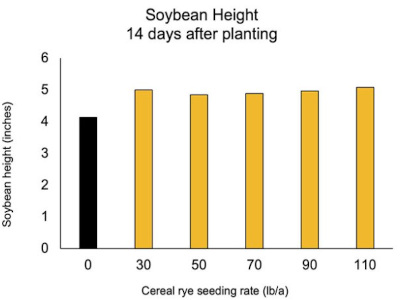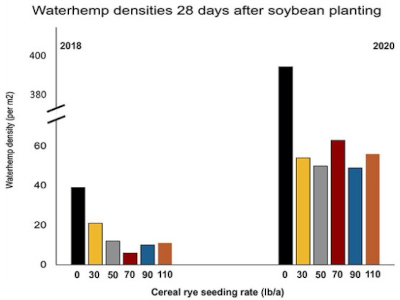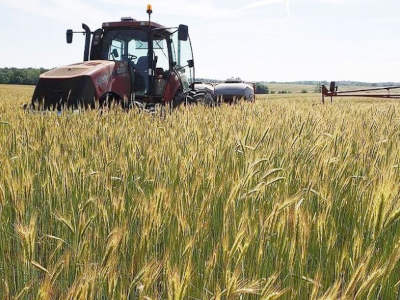
Figure 2 Soybean planted into cereal rye were taller than soybean planted into no cover (black bar), regardless of cereal rye seeding rate.
Weed suppression
Cereal rye, nor any cover crop, should be viewed as a silver bullet for weed control. And, understanding the soil seedbank is extremely important when making decisions about how to most effectively integrate cover crops and chemicals for weed control.
In this study, we determined waterhemp emergence at 2, 4, and 6 weeks after soybean planting. The biomass generated from cereal rye was sufficient to reduce waterhemp emergence for four weeks in 2018 and for 6 weeks in 2020 when compared to plots that lacked a cereal rye cover crop (Figure 3).

Figure 3 Waterhemp counts were conducted 4 weeks after soybean planting.
Unfortunately, the situation was much different in 2019. Cereal rye biomass generated in the spring of 2019 was comparable to 2018 and 2020. However, waterhemp densities at the 2019 trial site were approximately 1,000 seedlings per m-2 and approximately 20- and 3-fold higher than the 2018 or 2020 sites. Cereal rye biomass could not compensate and the waterhemp densities were the same in the plots with a cereal rye cover crop as in those without a cover crop, regardless of cereal rye seeding rates.
A producer who was hoping for early-season waterhemp suppression would have been greatly disappointed if our trial site in 2019 was his/her only experience with cereal rye. This is one reason why understanding the specific weed species and quantities of weed seed present in the soil seedbank is so important.
This study was conducted in the absence of residual herbicides. Would adding residual herbicides have helped reduce waterhemp emergence? Yes, and especially in 2019 when waterhemp densities were so high. So, when is the best time to apply residual herbicides when a cover crop is present?
If you plan to include a pre-emergence residual herbicide, our data show that applying it before cover crops like cereal rye start their rapid period of spring growth is best for ensuring the herbicide makes it to the soil surface. In previous research we analyzed concentrations of sulfentrazone (Authority) in the soil following application of the herbicide over the top of cover crops at either 3 weeks or 1 week prior to soybean planting. For cereal rye specifically, about 40% more sulfentrazone reached the soil surface when applied over the smaller cereal rye (approximately 13 inches) at 3 weeks prior to soybean planting compared to the larger cereal rye (approximately 30 inches) at 1 week prior to soybean planting.

Figure 4 Photo is from 2019. A mid-Missouri producer had not intended to plant into living cereal rye but had no options following the wet spring.
What is your experience? In 2019, most of Missouri had an extremely wet spring. Some of you may have had your hand forced and had to plant your crop into living cereal rye given the lack of time to terminate the cover crop in advance (Figure 4). When did you add the residual? What were your observations that year? Feel free to connect with us via e-mail and share.
Source : missouri.edu